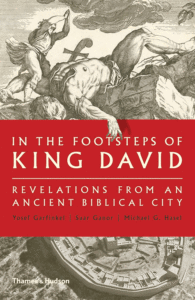Reviewed by NEAL GENDLER
Was King David a real person?
Three archaeologists say evidence at a hilltop overlooking Israel’s Elah valley strongly suggests so.

Their findings, reported clearly and engagingly inIn the Footsteps of King David, rebut a recent “minimalist” theory claiming that Kings David and Solomon were imaginary.
“The Bible without King David would have to be completely rewritten,” the authors say, and David’s influence is readily apparent to Yosef Garfinkel, Saar Ganor and Michael G. Hasel, leaders of a seven-season dig at a previously unidentified city, a site called Khirbet Qeiyafa.
Excavation from 2007 through 2013 exposed 54,000 square feet, about 25 percent of the site, revealing rooms and their uses, household goods, weights, daggers, arrowheads, a bronze ax head, three iron swords, Egyptian amulets and three stone seals.
Most striking was an ostracon — a piece of pottery with writing — that analysis showed was Hebrew in Canaanite lettering, “making this the most ancient known Hebrew inscription.” Its fourth line apparently says: “Guilt, revenge, a king will be lost.”
Olive pits were radiocarbon dated to the end of the 11th and beginning of the 10th centuries before the common era, the transition from Iron Age I to Iron Age II, when King David is said to have consolidated rule over Judah.
“In 2007, the name Khirbet Qeiyafa was unknown to both professional archaeologists and the public,” they say. “In 2008, it became world famous when the New York Times dedicated a full page to a description of the site, its excavation and the preliminary results.”
The reason was evidence linking to famous King David, “a very elusive figure from the archaeological or historical point of view.” Previously, no archaeological layer related to him had been identified, they say.
The authors identify Khirbet Qeiyafa as biblical Shaaraim, or “two gates,” which the city has. Mentioned twice in the Bible in connection with young David, it is a day’s walk from Jerusalem, and exactly in the area and era of the famous battle with Goliath, whose city of Gath is nearby.
Khirbet Qeiyafa is near the border between Judah and Philistia, leading to regular strife. Biblical traditions “may sound like gross exaggeration to readers today, but modern research is less interested in the precise content of the events described [than] the fascinating correspondence” between locations in biblical tradition and those found in research.
Khirbet Qeifaya “is the earliest example of urban planning in Israel involving a casemate [double] wall that incorporates the casemate as rooms,” showing not only that King David built cities “but that a new concept in urban planning emerged during his reign.”
Such construction wasn’t yet used in the northern kingdom, Israel, which the authors say formed later.
The authors describe Khirbet Qeiyafa in historical context, including relationships among cities, use of rooms, means of tax payment, even baking of bread on a pitted plate, shown in a photo.
Unearthed were 683 jar handles into which the the potter had pressed a finger, apparently for identification, the most ever found.
Some rooms were used both for living and for cult purposes, and — unlike nearby Philistine sites — the period’s bone pits contained none from pigs.
The city was fully inhabited for only a generation, the authors say, although it was used briefly in Persian and early Hellenistic periods, which they describe in an annex. The 10th century layer showed sudden destruction; household goods hadn’t been removed but were smashed into what so far is 400,000 pottery pieces.
Footsteps is a very readable book, like articles in Biblical Archeology Review, with 107 illustrations. In colloquial English, it avoids jargon, explains scientific terms and methods, and gives distances and dimensions in both metric and English measures.
A Hebrew edition written during excavations sold more than 8,000 copies. This English edition gives a more complete picture. It is enlightening, entertaining and a possible step toward physical proof of King David.
***
Neal Gendler is a Minneapolis writer and editor.
(American Jewish World, 7.27.18)




















